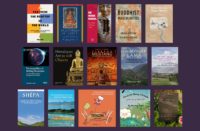
Published in July 2014 by Brill, in “The Archaeology of Tibetan Books” Agnieszka Helman-Ważny explores the varieties of artistic expression, materials, and tools that have shaped Tibetan books over the millennia.
From the Brill website:
Digging into the history of the bookmaking craft, the author approaches these ancient texts primarily through the lens of their artistry, while simultaneously showing them as physical objects embedded in pragmatic, economic, and social frameworks. She provides analyses of several significant Tibetan books—which usually carry Buddhist teachings—including a selection of manuscripts from Dunhuang from the 1st millennium C.E., examples of illuminated manuscripts from Western and Central Tibet dating from the 15th century, and fragments of printed Tibetan Kanjurs from as early as 1410. This detailed study of bookmaking sheds new light on the books’ philosophical meanings.
Agnieszka Helman-Ważny, Ph.D. (2007) is a Research Associate at the University of Arizona and University of Hamburg. Her research focuses on the history of paper and books in Tibet and Central Asia and developing methods for their examination and conservation.
Buy the book on Amazon here: http://amzn.to/1CCYXvR





Follow Us!